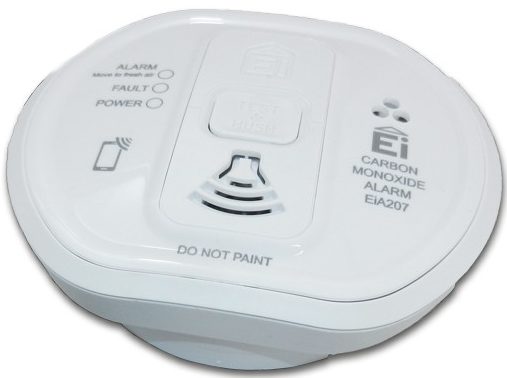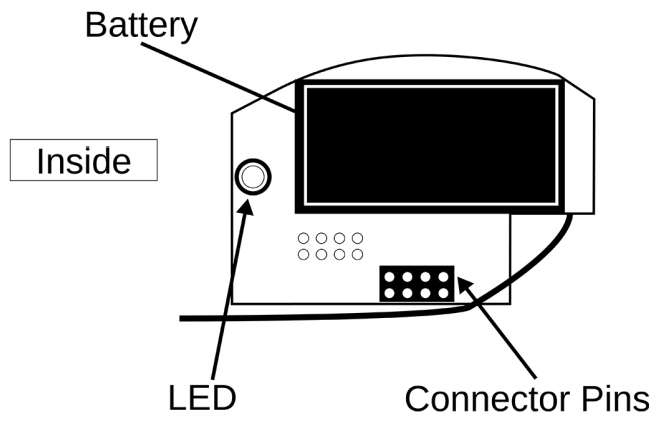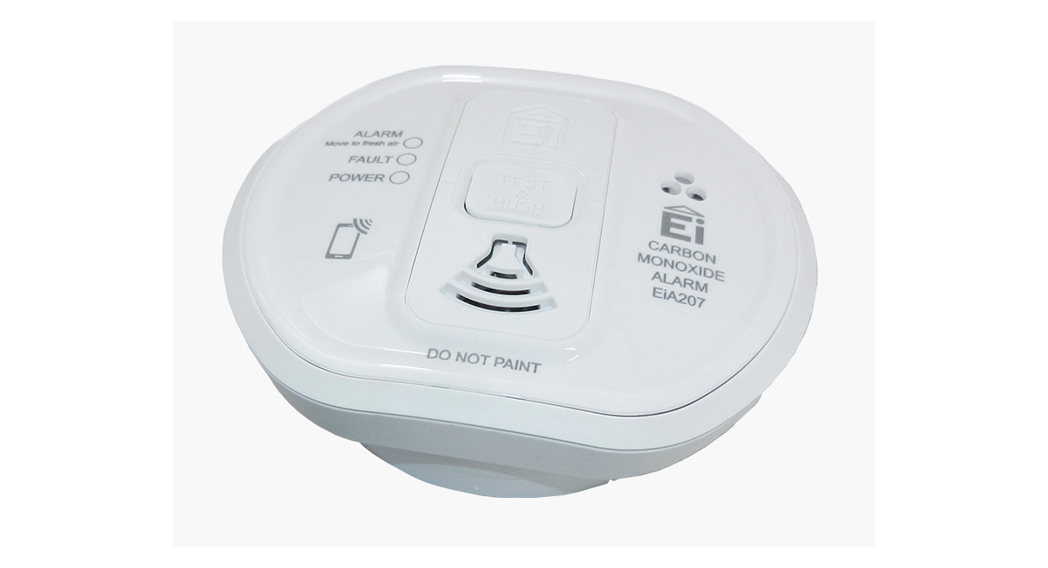 Z-Wave CO DetectorSKU: POPE004407
Z-Wave CO DetectorSKU: POPE004407


Quickstart
This is a secure Z-Wave Device for Europe. To run this device please insert fresh 1 * CR14250 batteries. Please make sure the internal battery is fully charged.Pressing the “Z-Wave button” for one second adds (includes) and removes (excludes) the device from/to the Z-Wave network.
Important safety information
Please read this manual carefully. Failure to follow the recommendations in this manual may be dangerous or may violate the law. The manufacturer, importer, distributor, and seller shall not be liable for any loss or damage resulting from failure to comply with the instructions in this manual or any other material. Use this equipment only for its intended purpose. Follow the disposal instructions. Do not dispose of electronic equipment or batteries in a fire or near open heat sources.
What is Z-Wave?
Z-Wave is the international wireless protocol for communication in the Smart Home. This device is suited for use in the region mentioned in the Quickstart sectionZ-Wave ensures reliable communication by reconfirming every message (two-way communication) and every mains-powered node can act as a repeater for other nodes (meshed network) in case the receiver is not in direct wireless range of the transmitter.
![]() This device and every other certified Z-Wave device can be used together with any other certified Z-Wave device regardless of brand and origin as long as both are suited for the same frequency range.If a device supports secure communication it will communicate with other devices secure as long as this device provides the same or a higher level of security. Otherwise it will automatically turn into a lower level of security to maintain backward compatibility.For more information about Z-Wave technology, devices, white papers, etc. please refer to www.z-wave.info.
This device and every other certified Z-Wave device can be used together with any other certified Z-Wave device regardless of brand and origin as long as both are suited for the same frequency range.If a device supports secure communication it will communicate with other devices secure as long as this device provides the same or a higher level of security. Otherwise it will automatically turn into a lower level of security to maintain backward compatibility.For more information about Z-Wave technology, devices, white papers, etc. please refer to www.z-wave.info.
Product Description
This product combines a certified carbon monoxide detector with a plug-in Z-Wave module to form a wirelessly reporting carbon monoxide sensor. The high-end carbon monoxide detector offers a test button conveniently accessible even with a broom stick when mounted on the ceiling. Three colored LEDs on the device indicate Alarm, Error, and Battery Level. The Alarm conditions is reported wirelessly using Z-Wave. Besides the Carbon monoxide danger alarm the device will also report a tamper alarm if the sensor is removed from the mounting base. The device is a secure Z-Wave Plus device and can be used in one wireless Z-Wave net with other certified devices regardless of origin and brand.
Prepare for Installation / Reset
Please read the user manual before installing the product.In order to include (add) a Z-Wave device to a network, it must be in the factory default state. Please make sure to reset the device into factory default. You can do this by performing an Exclusion operation as described below in the manual. Every Z-Wave controller is able to perform this operation however it is recommended to the primary controller of the previous network to make sure the very device is excluded properly from this network.Reset to factory defaultThis device also allows being reset without any involvement of a Z-Wave controller. This procedure should only be used when the primary controller is inoperableKeep The Z-Wave Button pressed for 10 seconds. the LED will start flashing after 5 secondsSafety Warning for BatteriesThe product contains batteries. Please remove the batteries when the device is not used. Do not mix batteries of different charging levels or different brands.
Installation
Please refer to the installation guide of the carbon sensor attached for information about how and where the carbon monoxide sensor should be installed. Please that the carbon monoxide sensor will also work stand-alone even if no Z-Wave network is present
 |
 |
- The first step is to mount the mounting base in the desired place in the home using screws.
- Remove the battery isolation strip from the wireless module. The red LED will start blinking.
- Include the sensor into your existing Z-Wave-based smart home network using the Z-Wave button.
- Place the detector on the mounting base and turn clockwise. Now the detector is armed.
- Battery change: The battery of the wireless module will be empty much earlier than the 10 years soldered in battery of the sensor. To replace the battery remove the detector and pull off the wireless module from the carbon sensor. Then you can replace the 1/2 AA battery and re-plug the wireless module.
Inclusion/Exclusion
On factory default, the device does not belong to any Z-Wave network. The device needs to be added to an existing wireless network to communicate with the devices of this network. This process is called Inclusion.Devices can also be removed from a network. This process is called Exclusion. Both processes are initiated by the primary controller of the Z-Wave network. The controller is turned into exclusion respective inclusion mode. Inclusion and Exclusion is then performed doing a special manual action right on the device.Inclusion
- Remove the ceiling bracket.
- Remove the Z-Wave board.
- Insert the battery.
- Replace the Z-Wave board.
- Press the button on the Z-Wave board once.
Exclusion
- Remove the ceiling bracket. 2. Press the button on the Z-Wave board once.
Product Usage
Operating the DeviceThere is no defined level of carbon monoxide that will result in an alarm. The danger of CO is a result of the total level of CO in the air plus the duration of exposure Z-Wave alarm will be sent out when one of the following conditions were met:
- CO level above 43 ppm for a duration of 60 minutes
- CO level above 80 ppm for a duration of 10 minutes
- CO level above 150 ppm for a duration of 2 minutes
The alarm will be sent to the central controller. Additionally, the alarm can be used to switch any other Z-Wave controllable actuator such as a Switch, a Dimmer o even a Door Lock that is placed in association group 2. The wireless module will also report a low (wireless module) battery warning. Please note that the battery of the main detector is not reported since this battery can?t be replaced anyway.Support for Command Class BASICThe device supports the generic Z-Wave command class BASIC. The device will ignore any SET command but return the status of the sensor on a GET common (triggered=0xff, idle=0x00).Alarm Messages
- The device will issue the following (unsolicited) alarm messages:
- CO Danger Detected (this message will also be issued when the test button is pressed)
- Low Battery Alarm (when the battery of the wireless modules goes low)
- Tamper Detected (ON, when the CO detector head is removed from the base; OFF, when the detector head is mounted to the base) Malfunction (issued, when the detector main head detects a malfunction of CO detection)
Node Information Frame
The Node Information Frame (NIF) is the business card of a Z-Wave device. It contains information about the device type and the technical capabilities. The inclu and exclusion of the device are confirmed by sending out a Node Information Frame. Besides this, it may be needed for certain network operations to send out a No Information Frame. To issue a NIF execute the following action: Single Click the Z-Wave Button on the bottom side module
Communication to a Sleeping device (Wakeup)
This device is battery-operated and turned into a deep sleep state most of the time to save battery life. Communication with the device is limited. In order to communicate with the device, a static controller C is needed in the network. This controller will maintain a mailbox for the battery-operated devices and store commands that can not be received during a deep sleep state. Without such a controller, communication may become impossible, and/or the battery life is significantly decreased.This device will wake up regularly and announce the wakeup state by sending out a so-called Wakeup Notification. The controller can then empty the mailbox. Therefore, the device needs to be configured with the desired wakeup interval and the node ID of the controller. If the device was included by a static controller the controller will usually perform all necessary configurations. The wakeup interval is a tradeoff between maximal battery lifetime and the desired responses of the device. To wakeup the device please perform the following action: Single Click the Z-Wave Button on the bottom side module
Quick troubleshooting
Here are a few hints for network installation if things don’t work as expected.
- Make sure a device is in a factory reset state before including it. In doubt exclude before include.
- If inclusion still fails, check if both devices use the same frequency.
- Remove all dead devices from associations. Otherwise, you will see severe delays.
- Never use sleeping battery devices without a central controller.
- Don’t poll FLIRS devices. 6. Make sure to have enough mains powered devices to benefit from the meshing
Firmware-Update over the Air
This device is capable of receiving a new firmware ‘over the air. The update function needs to be supported by the central controller. Once the controller starts the update process, perform the following action to confirm the firmware update: Once the firmware update process has started (wake up first by a single push of the Z-W button) double click the Z-Wave button to confirm the firmware update process.
Association – one device controls another device
Z-Wave devices control other Z-Wave devices. The relationship between one device controlling another device is called association. In order to control a different device, the controlling device needs to maintain a list of devices that will receive controlling commands. These lists are called association groups and they are all related to certain events (e.g. button pressed, sensor triggers, …). In case the event happens all devices stored in the respective association group will receive the same wireless command, typically a ‘Basic Set’ Command.
Association Groups:
| Group Number | Maximum Nodes | Description |
| 1 | 10 | Lifeline |
| 2 | 10 | Switching Command when Alarm |
Configuration Parameters
Z-Wave products are supposed to work out of the box after inclusion, however, certain configurations can adapt the function better to user needs or unlock further enhanced features.IMPORTANT: Controllers may only allow configuring signed values. In order to set values in the range 128 … 255 the value sent in the application shall be the devalue minus 256. For example: To set a parameter to 200it may be needed to set a value of 200 minus 256 = minus 56. In the case of a two-byte value, the same log applies: Values greater than 32768 may be needed to be given as negative values too.Parameter 1: Value of ON-CommandSize: 1 Byte, Default Value: 99
| Setting | Description |
| 0 – 99 | Send Basic Command by set Alarm |
Parameter 2: Value of OFF-CommandSize: 1 Byte, Default Value: 0
| Setting | Description |
| 0 – 99 | Send Basic Command by reset Alarm |
Technical Data
| Dimensions | 0.1040000×0.1190000×0.0430000 mm |
| Weight | 185 gr |
| Hardware Platform | ZM5202 |
| EAN | 0019962004407 |
| IP Class | IP 20 |
| Battery Type | 1 * CR14250 |
| Firmware Version | 01.00 |
| Z-Wave Version | 04.05 |
| Certification ID | ZC10-16035025 |
| Z-Wave Product Id | 0x0154.0x0004.0x0003 |
| Frequency | Europe – 868,4 |
| Maximum transmission power | Mhz 5 mW |
Supported Command Classes
|
|
Controlled Command Classes
- Basic
Explanation of Z-Wave specific terms
- Controller — is a Z-Wave device with capabilities to manage the network. Controllers are typically Gateways, Remote Controls, or battery-operated wall controllers.
- Slave — is a Z-Wave device without capabilities to manage the network. Slaves can be sensors, actuators, and even remote controls.
- PrimaryController — is the central organizer of the network. It must be a controller. There can be only one primary controller in a Z-Wave network.
- Inclusion — is the process of adding new Z-Wave devices into a network.
- Exclusion — is the process of removing Z-Wave devices from the network.
- Association — is a control relationship between a controlling device and a controlled device.
- Wakeup Notification — is a special wireless message issued by a Z-Wave device to announces that is able to communicate.
- Node Information Frame –– is a special wireless message issued by a Z-Wave device to announce its capabilities and functions.
http://manual.zwave.eu/backend/make.php?lang=en&sku=POPE004407
(c) 2020 Z-Wave Europe GmbH, Antonstr. 3, 09337 Hohenstein-Ernstthal, Germany, All rights reserved, www.zwave.eu. The template is maintained by Z-Wave Europe GmbH.The product content is maintained by Popp & Co., Support team, [email protected].Last update of the product data: 2020-02-04 14:56:13
References
[xyz-ips snippet=”download-snippet”]


